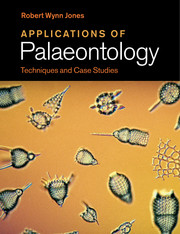Book contents
- Frontmatter
- Contents
- Preface
- Acknowledgements
- 1 Work-flows in applied palaeontology
- 2 Biostratigraphy and allied disciplines, and stratigraphic time-scales
- 3 Palaeobiology
- 4 Sequence stratigraphy
- 5 Petroleum geology
- 6 Mineral exploration and exploitation
- 7 Coal geology and mining
- 8 Engineering geology
- 9 Environmental science
- 10 Other applications and case studies
- References
- Index
10 - Other applications and case studies
Published online by Cambridge University Press: 05 February 2012
- Frontmatter
- Contents
- Preface
- Acknowledgements
- 1 Work-flows in applied palaeontology
- 2 Biostratigraphy and allied disciplines, and stratigraphic time-scales
- 3 Palaeobiology
- 4 Sequence stratigraphy
- 5 Petroleum geology
- 6 Mineral exploration and exploitation
- 7 Coal geology and mining
- 8 Engineering geology
- 9 Environmental science
- 10 Other applications and case studies
- References
- Index
Summary
APPLICATIONS AND CASE STUDIES IN ARCHAEOLOGY
In conventional palaeontology, fossils are typically used to provide information on the ages and environments of containing sediments.
In archaeology, the approach is subtly different, in that both sediments and fossils, including human remains and associated artefacts, and associated animal and plant remains, are used to provide information on the stratigraphic and environmental context of human evolution and dispersal, and of ancient human life and behaviour (Jones, 2006; see also comments on ‘Archaeostratigraphy’ and ‘Environmental archaeology’ below; Bobe et al., 2007; Dominguez-Rodrigo et al., 2007; Ungar, 2007; Grine et al., 2009; Hublin & Richards, 2009; Sinibaldi, 2010). The human remains provide information as to ancient human life and behaviour, and also as to disease and/or cause of death (Mays, 1998; Ortner, 2003; Roberts & Manchester, 2005). Tooth wear provides information as to diet; tooth composition, information as to the point of origination of the individual, and as to migration; DNA, as to the migration of populations (Renfrew & Boyle, 2000; Evans & Tatham, in Pye & Croft, 2004; Hillson, 2005; Weiner, 2010).
Information
- Type
- Chapter
- Information
- Applications of PalaeontologyTechniques and Case Studies, pp. 316 - 341Publisher: Cambridge University PressPrint publication year: 2011
